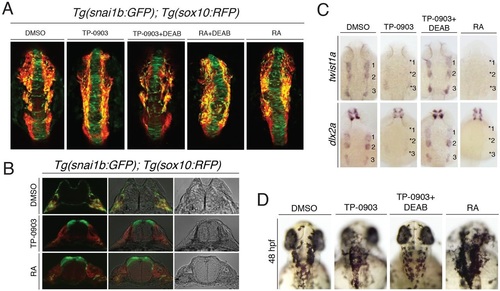Fig. 7
- ID
- ZDB-FIG-160428-25
- Publication
- Jimenez et al., 2016 - Phenotypic chemical screening using zebrafish neural crest reporters identifies retinoid acid as an inhibitor of epithelial morphogenesis
- Other Figures
- All Figure Page
- Back to All Figure Page
|
Retinoic acid controls cranial NC EMT, cell migration and ectomesenchyme differentiation. (A) Dorsal views of maximal z-projection confocal images of Tg(snai1b:GFP); Tg(sox10:RFP) embryos treated with the indicated compounds at 11.5hpf. TP-0903 inhibits NC EMT and cell migration, which is rescued by co-treatment with DEAB (16/18 embryos), an inhibitor of retinaldehyde dehydrogenase (RALDH), which is required for RA biosynthesis. In contrast, direct treatment with RA bypasses the requirement for RALDH and is not rescued by DEAB (0/19 embryos). (B) Transverse sections through the hindbrain of Tg(snai1b); Tg(sox10:RFP) embryos at 24hpf treated with DMSO, TP-0903 or RA confirms that RA treatment causes accumulation of GFP-positive dorsal neural tube cells similar to TP-0903 treatment (6/8 embryos). (C) Dorsal views of 24-hpf embryos processed by whole-mount in situ hybridization for twist1a and dlx2a mRNA, showing that inhibition of RA synthesis in TP-0903-treated embryos rescues expression of these genes in NC streams (numbered) (15/18 and 18/21 embryos, respectively), whereas RA treatment itself mimics TP-0903 and blocks expression of twist1a (14/16 embryos) and dlx2a (18/18 embryos). (D) Dorsal views of 48-hpf embryos, showing that melanophores accumulate on the head of TP-0903-treated embryos (17/19 embryos), which is rescued by DEAB co-treatment (17/20 embryos) and mimicked by direct RA treatment (19/20 embryos). |

